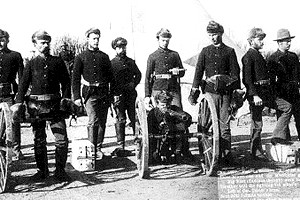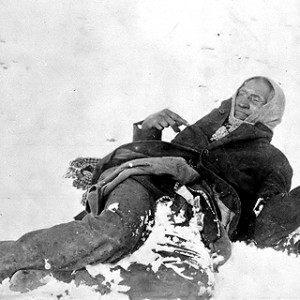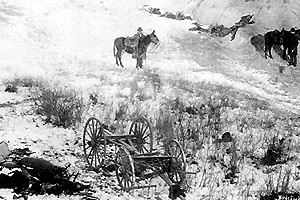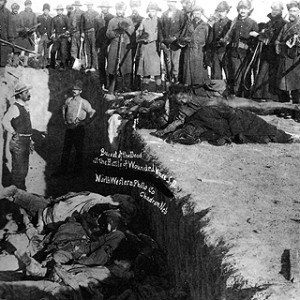December 29, 1890: A massacre by U.S. 7th Cavalry Regiment takes place near Wounded Knee Creek, South Dakota.
The massacre at Wounded Knee was one of the last major conflicts of the American Indian Wars, taking place on the Pine Ridge Indian Reservation of South Dakota. Just two weeks earlier, Lakota Sioux chief Sitting Bull was killed in a struggle against a group of policemen and volunteers (including his own brother-in-law) who had been ordered to arrest him to prevent him from using his influence to support the “Ghost Dance” movement, which was described by agents of the U.S. Indian Service as the “Messiah Craze”. Spotted Elk, another Lakota Sioux leader, was an enthusiastic devotee of this new movement that the American government tried desperately to suppress and outlaw. Spotted Elk and hundreds of his followers were intercepted and relocated by the 7th Cavalry Regiment on December 28, 1890 to Wounded Knee Creek, where the Lakota made camp.
By the next morning, around 500 troops had surrounded Spotted Elk’s camp, made up of 350 Native Americans, around two-thirds of which were women and children. As the 7th Cavalry searched the camp to confiscate any weapons, a scuffle broke out between one of the Lakota and the soldiers, which escalated into a “battle” that ended in around 300 Native American casualties, including 200 women and children killed. 31 soldiers ultimately died as well, although it is speculated that many had been killed by friendly fire, shot by the mounted Hotchkiss guns that had been placed around the camp. Fighting lasted less than an hour, but it was brutal, bloody, and cruel. According to the commanding general, Nelson Miles, “a large number of women and children who tried to escape by running and scattering over the prairie were hunted down and killed”. The 1891 report of the Commissioner of Indian Affairs contained descriptions by surviving Lakota of the events of the massacre:
All the men who were in a bunch were killed right there, and those who escaped that first fire got into the ravine, and as they went along up the ravine for a long distance they were pursued on both sides by the soldiers and shot down, as the dead bodies showed afterwards….
There was a woman with an infant in her arms who was killed as she almost touched the flag of truce, and the women and children of course were strewn all along the circular village until they were dispatched. Right near the flag of truce a mother was shot down with her infant; the child not knowing that its mother was dead was still nursing, and that especially was a very sad sight.
Spotted Elk himself (pictured above) was killed during the fight. Medals of Honor were awarded to twenty of the troopers who fought at Wounded Knee (listed here), some of them for, ironically, “extraordinary gallantry”, “distinguished conduct”, and “conspicuous bravery”. Like most of the conflicts of the Indian Wars, the Wounded Knee Massacre was often brushed over in popular history until the 1970s during a period of Native American activism, and after the release of the popular book Bury My Heart at Wounded Knee.





